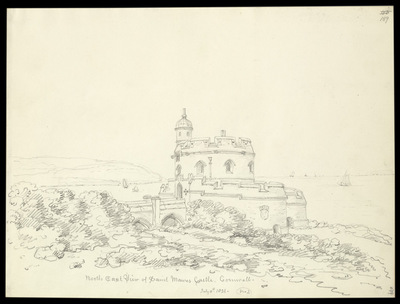Javascript must be enabled to continue!
Saint Mawes Castle, Cornwall
View through Europeana Collections
Henry VIII built Mawes Castle between 1539 and
1545 on the eastern shore of the River Fal estuary. The castle was
constructed with a large central tower flanked by three circular
bastions giving gun placements to cover all angles of approach.
Mawes was one of several castles built by Henry in his strategy to
protect the southern coastline from potential invasion from French
or Spanish fleets. During his reign however, this castle saw no
action.Elizabeth I, anticipating a full-scale Spanish invasion
after raids further along the coast in 1595, strengthened the
castle's defences. Again, no invasion materialised and it was only
in the Civil War during the 1640s that the castle became engaged in
military activity. The Royalist captain surrendered St Mawes to
Parliamentarian troops shortly after being
confronted.
The British Library
Title: Saint Mawes Castle, Cornwall
Description:
Henry VIII built Mawes Castle between 1539 and
1545 on the eastern shore of the River Fal estuary.
The castle was
constructed with a large central tower flanked by three circular
bastions giving gun placements to cover all angles of approach.
Mawes was one of several castles built by Henry in his strategy to
protect the southern coastline from potential invasion from French
or Spanish fleets.
During his reign however, this castle saw no
action.
Elizabeth I, anticipating a full-scale Spanish invasion
after raids further along the coast in 1595, strengthened the
castle's defences.
Again, no invasion materialised and it was only
in the Civil War during the 1640s that the castle became engaged in
military activity.
The Royalist captain surrendered St Mawes to
Parliamentarian troops shortly after being
confronted.
Related Results
Saint Matthew the Evangelist
Saint Matthew the Evangelist
Gabriel Mälesskircher may have trained in the Low Countries, from where he derived his technique and approach to representing reality. Mälesskircher has been identified as the youn...
Saint John the Evangelist
Saint John the Evangelist
Gabriel Mälesskircher may have trained in the Low Countries, from where he derived his technique and approach to representing reality. Mälesskircher has been identified as the youn...
The Miracle of the Hosts at the Tomb of Saint John the Evangelist
The Miracle of the Hosts at the Tomb of Saint John the Evangelist
Gabriel Mälesskircher may have trained in the Low Countries, from where he derived his technique and approach to representing reality. Mälesskircher has been identified as the youn...
Saint Luke the Evangelist
Saint Luke the Evangelist
Gabriel Mälesskircher may have trained in the Low Countries, from where he derived his technique and approach to representing reality. Mälesskircher has been identified as the youn...
Saint Mark the Evangelist
Saint Mark the Evangelist
Gabriel Mälesskircher may have trained in the Low Countries, from where he derived his technique and approach to representing reality. Mälesskircher has been identified as the youn...
Saint Luke painting the Virgin
Saint Luke painting the Virgin
Gabriel Mälesskircher may have trained in the Low Countries, from where he derived his technique and approach to representing reality. Mälesskircher has been identified as the youn...
The miracle of Saint Matthew taming the Dragons
The miracle of Saint Matthew taming the Dragons
Gabriel Mälesskircher may have trained in the Low Countries, from where he derived his technique and approach to representing reality. Mälesskircher has been identified as the youn...
The Martyrdom of Saint Mark
The Martyrdom of Saint Mark
Gabriel Mälesskircher may have trained in the Low Countries, from where he derived his technique and approach to representing reality. Mälesskircher has been identified as the youn...




